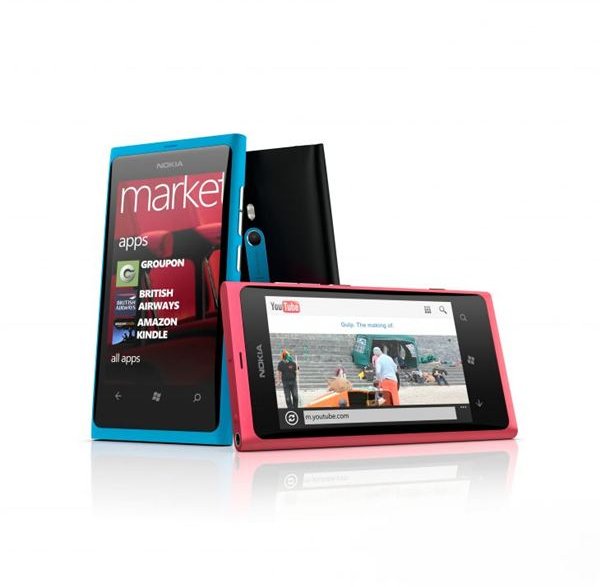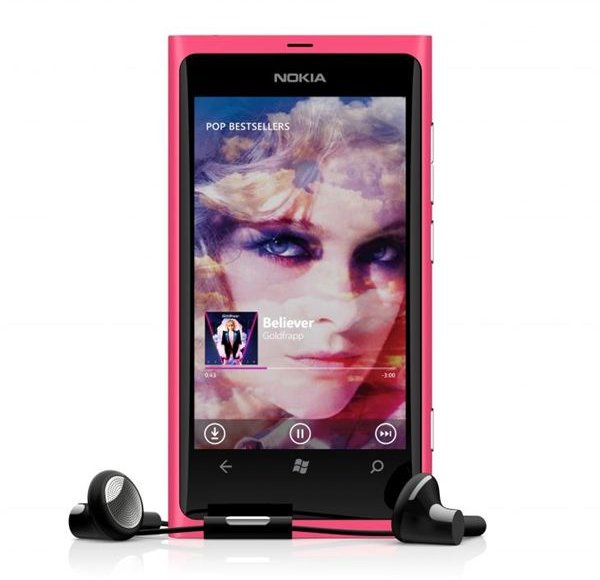The Future of Nokia: Lumia 800 Review

The Lumia 800 was announced in October 2011 at the Nokia World conference in London with the official consumer release slated for November 2011. This is a significant milestone for Nokia as it marks the beginning of a new era. This phone was designed and developed in just six months with two companies working hand in hand to make this work, which in itself is a pretty impressive feat.
The Lumia 800 stands out with Nokia’s signature vivid color designs and the new look which evolved from the Nokia N8 through to the MeeGo based Nokia N9. We now see it in the Lumia 800.
This is a classy looking phone. It is relatively lightweight and fits snugly into the palm of an adult hand. It is easy to handle, therefore giving unrestricted access to different parts of the display which also doubles as the control interface.
Let us start off by taking a more comprehensive look at the design.
Design (5 out of 5)
The Nokia Lumia 800 comes wrapped in a carefully crafted single piece polycarbonate plastic that blends particularly well with a curved glass panel that provides a surface that is naturally suitable for swiping with the thumb. The entire phone measures 116.5 x 61.2 with a thickness of 12.1 millimeters and it weighs in at 142 grams.
Right out of the box the Lumia 800 comes in Black, Magenta or Cyan. The general phone shape portrays different impressions depending on the angle from which you look at it. Taking a look at this phone from the top or from the sides reveals a curved body, while looking at it from the front reveals a phone that would be regarded as an almost perfect rectangle.
The front of the Nokia Lumia 800 is taken up by two primary components. There is the ear piece slot which is placed at the top edge and below that there is the blend into the glass surface that extends right down to the bottom of the phone. This glass surface houses the Nokia logo, the Proximity sensor for auto turn-off, the 3.7 inch display and the three Windows Phone softkeys right below the display.
The bottom of this WP 7 based phone has the external speaker. The top side of the phone comes with the slot for the 3.5 millimeter audio jack, the slot for connecting the battery charger, the slot for connecting the microUSB cable and finally the MicroSIM card.
The back of this Nokia smartphone is left to the dual LED flash and the primary camera lens.
User Interface (5 out of 5)

The Nokia Lumia 800 comes with a stunning Microsoft Windows Phone 7.5 Mango based user interface. Its primary functions are based on simple swipe and tap gestures. The complexities of deep rooted menus are noticeably absent from this mobile device’s user interface.
Scrolling, flipping, flicking, pinching and panning are all quite responsive. Animations are fluid and intuitive as well. The user interface comes with clever and subtle animations that make it a pleasure to navigate through. The color scheme of the user interface is cleverly designed to match the body of the device. You can access major applications such as social networks, the music player and the Internet right from a single tap on the home screen. This is, of course, in addition to functions such as call and messaging which are provided in threaded view.
Softkeys, which come in the form of touch sensitive icons, provide access to the menu and device-wide context sensitive search features. Calls can be made by selecting users from the address book or by keying in numbers on the full touch screen QWERTY keyboard or interchangeable alphanumeric keypads available in both orientations.
There are some elegant surprises with this Nokia device such as the ability to shake and have the device recommend an application to you which you can then download and install.
In general when all is said and done. The beauty in the user interface of the Nokia Lumia 800 lies in the visuals and simplicity provided by Microsoft Windows Phone 7.5 and its tight integration with the Nokia hardware and the response and feel the two bring working in sync.
Features (3 out of 5)
Quite hard to miss, the Nokia Lumia 800 comes with an AMOLED capacitive touch screen that supports about 16M colors with a resolution of 480 x 800 pixels. The display features Gorilla Glass display technology. Under the hardware you will find Nokia ClearBlack display technology. This is technology that gives a more realistic black color on the display even if the contrast is turned higher.
The multi-touch input method is supported on this display below which are touch sensitive Softkey controls. In addition to this there is a proximity sensor for auto turn-off and an accelerometer sensor for user interface auto-rotate.
As far as audio goes, there is an external loud speaker attached to the phone and an option for connecting the standard 3.5mm audio jack. You will also find a stereo FM radio with RDS.
Other media services offered on the Lumia 800 include an audio player with support for MP3, WAV, eAAC+ and WMA as well as a video player with support for MP4, H.264, H.263 and WMV file formats.
This phone comes with a single 8 MP camera with support for a 3264 x 2448 pixels maximum resolution. It comes fixed with a Carl Zeiss optics lens with autofocus accompanied by a dual-LED flash. Geo-tagging is supported on this device. The Nokia Lumia 800 is also capable of shooting video clips at the rate of 30 frames per second with a maximum video resolution of 720p in HD. This is all topped off with a video and photo editor.
Memory on the Nokia Lumia 800 is restricted to 16 GB with 512 MB RAM. There is no external memory card support on this device, but it comes with support for external USB storage.
As for connectivity, GPRS and EDGE is maintained with 3G supported with speeds of up to 14.4 Mbps on HSPDA and 5.76 Mbps on HSUPA. There is also the option of using Wi-Fi wherever available. Bluetooth comes standard with this device and so does microUSB for device to computer connectivity.
Other hardware features include a digital compass and a GPS receiver with support for A-GPS. The hardware is driven by Microsoft Windows Phone 7.5 Mango as the underlying operating system.
Performance (4 out of 5)

The Nokia Lumia 800 comes with modest performance gains in most areas. Being driven by a 1.4 GHz Scorpion processor, Qualcomm MSM8255 Snapdragon chipset and an Adreno 205 Graphics Processing Unit (GPU) for 3D Graphics Hardware Acceleration, this Nokia phone offers pretty good performance when launching and managing applications and running games. It is much faster and more fluid than many other mobile phones on the market.
Internet connectivity is quite reliable. It even picks up 3G and Wi-Fi signals much faster than other devices. Download speeds are also pretty impressive, of course this could be partly due the responsible network source. Phone connectivity is also excellent with much better sensitivity and response to cell network signals. Voice call quality is awesome and it has pretty good noise canceling abilities too.
The stereo audio quality is also excellent with a crystal clear sound performance for both audio and video. Video quality on the display is good, even in outdoor areas with the sun shining brightly. The screen contents can still be viewed even at deep angles and text provides a great contrast. This makes the Nokia Lumia 800 great for reading text based content.
GPS is quite responsive and accurate and takes a significantly shorter time to zero in on the GPS signals. The camera on this Windows Phone 7.5 device is also pretty good compared to several peers. The light sensitivity is quite acceptable as well. There is still much that can be improved as far as the picture quality goes, but I would say this phone has hit above average on the performance grid.
Verdict (4 out of 5)
The strength of the Nokia Lumia 800 lies in its precision crafted design which has unmistakeably borrowed heavily from the Nokia N9 MeeGo phone that Nokia released a few months before this phone was announced. This phone, however, comes with much fewer feature specifications.
The user interface is another point that gives this device a much needed boost as a flagship device. The hardware features are not that impressive, but considering this phone was designed in a rush, I am willing to excuse Nokia for now. All in all the Nokia Lumia 800 is going in the right direction and is definitely a major shift from Symbian^3. For about 420 Euros, this phone could be something you want to consider as you await the approaching Windows Phone 8 devices.
References
- Image Credit, press.nokia.com
- Nokia Press, press.nokia.com/2011/10/26/nokia-showcases-bold-portfolio-of-new-phones-services-and-accessories-at-nokia-world/
- Nokia Europe, europe.nokia.com